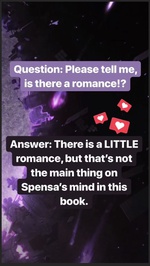Brandon Sanderson
Yes, it's looking like my next series--after Warbreaker, which is looking like it will be a two-book cycle--will be set in the Dragonsteel world. I'm revamping the setting significantly, mashing it together with Aether of Night, which always had a cool magic system but a weaker plot.
I have some sample chapters done, actually. Dragonsteel is now the series name, and the first book will be titled "The Liar of Partinel." (Probably.) The book you all read (now tentatively titled "The Eternal War") will be the third or fourth book in the series, and we will wait that long to introduce Jerick, Ryalla, and Bat'Chor. "Liar" will take place some five hundred years before "The Eternal War."
Brandon Sanderson
Mistborn was my fourteenth book, Elantris my sixth. One, named Dragonsteel, was my seventh and a number of the people on my forums knew me when I started writing it. It was, in a way, the book that 'made me famous' among my group of friends. So, many of them are excited to hear that I'm reworking the setting and planning to do the book for the big leagues. Dragonsteel Prime, the original, just isn't publishable as is. There were some great ideas, but I didn't have the skill at the time to make them work. So, I'm stealing some of the best ideas--and characters--and planning a new series around them. Hence Ookla calling me a cannibal, since I'm 'Cannibalizing' my old ideas to make new books.
The following is a complete Brandon Sanderson Bibliography, published and unpublished. Prime indicates an early attempt at a book which was later redone. (Note that when I redo a book like this, it isn't a 'rewrite.' Generally, it's me taking some elements from the setting and writing a whole new book in that setting, using old ideas and mixing them with fresh ones.) Published books are in bold.
1) White Sand Prime (My first book, took two + years to write. 1998)
2) Star's End (Science fiction. 1998)
3) Lord Mastrell (Sequel to White Sand Prime. 1999)
4) Knight Life (Fantasy comedy. 1999)
5) The Sixth Incarnation of Pandora (Science fiction. 1999)
6) Elantris (2000. Published by Tor: 2005)
7) Dragonsteel (2000)
8 ) White Sand (2001)
9) Mythwalker (Never finished. 2001)
10) Mistborn Prime (Stole the magic system and title for a later book. 2002)
11) Final Empire Prime (Stole a character, some setting elements, and title for a later book. 2002)
12) The Aether of Night (2002)
13) The Way of Kings (350,000 words. Took a long time. 2003)
14) Mistborn: The Final Empire (2004, Published by Tor 2006)
15) Mistborn: The Well of Ascension (2005. Contracted to Tor for 2006)
16) Alcatraz vs. The Evil Librarians (2005. Contracted to Scholastic for 2006)
17) Mistborn: The Hero of Ages (2006. Contracted to Tor for 2007)
18) Warbreaker (2006. Tentatively to be released by Tor for 2007)
19) Alcatraz vs. The Scrivener's Bones (2006. Contracted by Scholastic for 2008)
20) Dragonsteel: The Liar of Partinel (Unfinished. 2007?)
21) Alcatraz vs. The Knights of Crystallia (Planned. 2007 Contracted by Scholastic for 2009)
22) Nightblood (Planned. 2008)
23) Dragonsteel: The Lightweaver of Rens (Planned. 2008)
24) Alcatraz vs. The Dark Talent (Planned. 2008. Contracted for Scholastic for 2010)
I'm not sure if I got all of those dates right, but the order is correct. I'm finished with all the books up to Dragonsteel, though Mistborn 3, Warbreaker, and Alcatraz 2 are all only in the third draft stage.
Brandon Sanderson
You DON'T have to have read the other Dragonsteel to understand this. The other Dragonsteel will never be published. Some of the plots and characters in it, however, will eventually become book three of this series. Not because I'm doing a 'Dragonlance' type thing, but because when I sat down to work on this project, I realized that I'd rather start back in time a few hundred years. In other words, I'm writing the prequels first, if that's possible.
Brandon Sanderson
In worldbuilding this, I realized that I missed a big opportunity in Dragonsteel Prime by not dealing with fainlife all that much. It was a powerful world element that got mostly ignored. By writing a book here, where I can slam a city in to the middle of the fain assault--before people learned really how to keep the alien landscape back--I think I'll be able to focus more on the setting.
One thing that always bothered me about Dragonsteel Prime is that it felt rather generic for me. I like more distinctive settings, with more distinctive magics. Yet, Dragonsteel Prime had a fairly standard fantasy world (though one set in the bronze age) with magic that didn't really get used all that much in the first book. The idea here is to add the Aether magic in, which is a 'day-to-day' magic, and to enhance the originality of the setting by using fainlife more. Microkenisis, Realmatic Theory, Cognitive Ripples and Tzai Blows, and all of that will STILL be part of this world. I've simply folded the Aethers in as well, and hopefully I can make it all feel cohesive.

